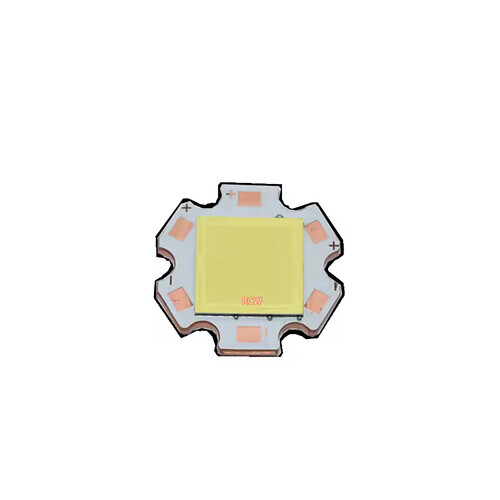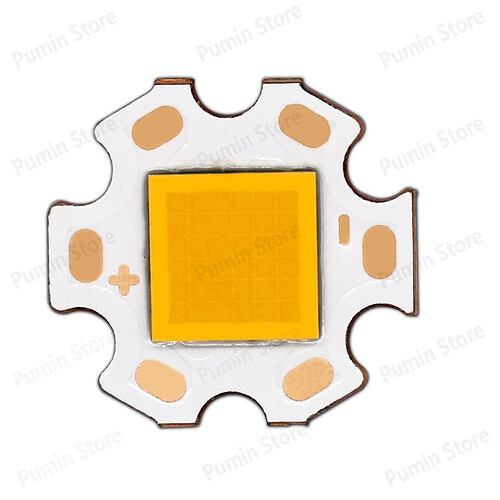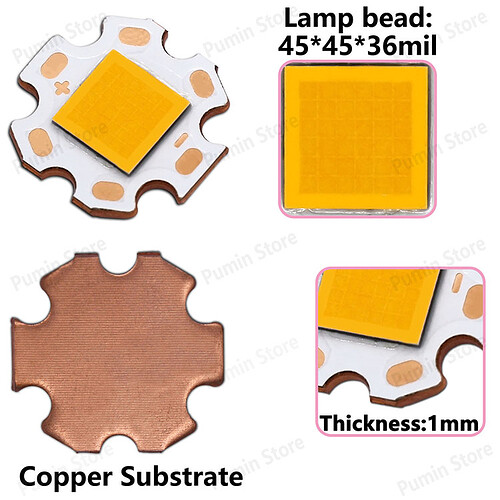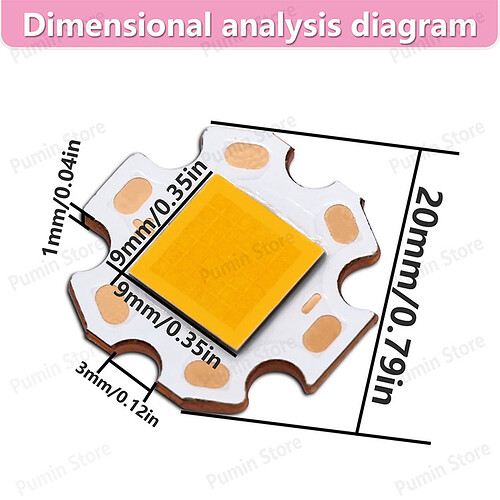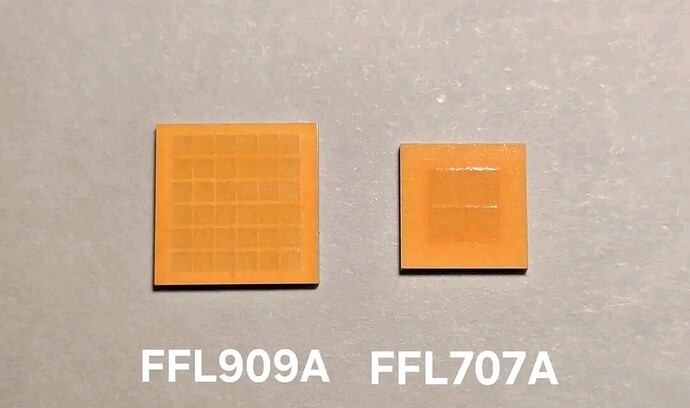2024-11-16
- Type: multi-die, 36 chips
- Bin: —
- Color group: unknown (6500 K)
- CRI: unknown, 80 CRI measured
- Rated voltage: 3 - 3.2 V
- Max. Forward current: 18,000 mA
- Max. Peak current: — mA
- Viewing angle: — °
- Thermal resistance: — K/W
- Max. Temperature Tj: max. —°C
The LED tested here was regularly purchased from Kaidomain in September 2024.
Note: There is no datasheet available. The above specifications were taken from the Kaidomain article description and may therefore be incorrect!
The HT96 is a very unusual LED. With dimensions of 9.25 x 9.25 mm, it is smaller than a Luminus SBT90.2, but larger than a classic 7070 LED. The most striking feature is the 36 small LED chips, which are arranged in an array of 6x6 LEDs and thus create a very large illuminated area. The gaps between the LED chips are hardly pronounced, which should result in a good light image, at least with textured reflectors (OP).
The illuminated area is almost reminiscent of a very low-resolution screen with 36 pixels. It is noticeable that not all segments shine equally brightly at low current - a typical problem for multi-die LEDs, which had already been noticed earlier with the MT-G2 and which is why many manufacturers specify a certain minimum current in their data sheets.
A disadvantage is the strong illumination of the surrounding surfaces, which massively reduces the luminance and possibly impairs the light quality due to color distortions in the beam. It is therefore not possible to specify the exact luminous area in mm².




- at 18,000 mA (official maximum current): 4881 lm @ 3.01 V
- Power at official maximum: 54.1 W
- Efficiency at 18,000 mA: 90.2 lm/W
- Maximum reached at 45 A, at this point 7827 lm @ 3.39 V
- Power at maximum 152.7 W
- Efficiency at maximum 51.3 lm/W



Data for 25 °C Tsp (at 85 °C the luminance values are around 13 % lower).
At first glance, the efficiency of the HT96 does not appear to be very high (for comparison: an SFH55 6500 K achieves 181.6 lm/W at 1 A, while the HT96 only achieves 140.5 lm/W). The Vf is extremely low. At 5 A it contributes just 2.74 V! This makes the use of FET-based drivers more difficult in that attention must be paid to the official maximum current of the MOSFET used in order to avoid destroying the driver if it is frequently operated on turbo. When using classic 105c drivers, the regulation would be given until the end of the battery life - even with an empty battery, the HT96 still reaches 3-5 A!
The SFH55 mercilessly pulls away from the HT96. This is probably mainly due to the very small chips of the HT96, which are only 0.83 x 0.83 mm in size. At maximum current, each of these chips only achieves 217 lm. This is very little, as similarly sized chips can achieve 300-500 lm. A higher thermal resistance may therefore also play a significant role.
The luminance is extremely low; the LED is only suitable for floodlights. In this respect, it is very similar to other LEDs with a similar design.
As for the beam… I don’t have a light in which I could install this LED as a test (the ones with a sufficiently large reflector all have a 6 V driver, which cannot simply be replaced by a 3 V version). However, a quick test with a (too small) OP reflector produced an impeccable light pattern, which should make this LED suitable for flashlights without any problems.

The measurement of the color quality holds a surprise. The HT96 is - at least judging by my only test sample - an 80 CRI LED. The color quality, especially in red and brown tones, is visibly better than with normal 70 CRI LEDs. This deviation is caused by the less pronounced cyan hole at 490 nm.
At almost 9000 K, the LED provides a strong bluish-white light, which is nevertheless subjectively quite pleasant due to the negative duv of -0.0023. Nevertheless, this LED is definitely not recommended for lovers of warm and neutral white color tones. The light color is most comparable to a B35AM in 6500 K, whereby this “only” has about 7400 K and also has a very high color rendering.
It seems as if the HT96 was manufactured for a specific customer order or a specific project. The design with the 36 individual chips, the color temperature and above all the color rendering are too specific. Such a quality of light is not simply produced during the manufacture of a 70 CRI LED, as there is serial dispersion when applying or mixing the phosphor. It can be assumed that this LED was only produced in small quantities and will therefore soon no longer be available.
- Ra: 81
- R9: 17
- CCT: 8800 K
- duv: -0.0023
An interesting LED with high performance, good beam pattern (tested in OP reflectors) and quite high color quality. About 1000 to 1500K warmer with slightly increased efficiency and this LED would be an excellent all-rounder LED for high performance flashlights while maintaining acceptable light quality.
Thank you for reading this test. ![]()
